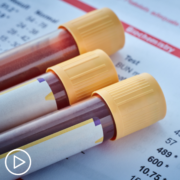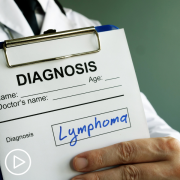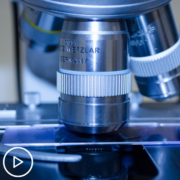Which chronic lymphocytic leukemia (CLL) tests are essential for patients? Dr. Lyndsey Roeker shares details about vital tests for CLL and the influence of results on treatment and prognosis.
Dr. Lyndsey Roeker is a hematologic oncologist at Memorial Sloan Kettering Cancer Center. Learn more about Dr. Roeker here.
Katherine:
What tests are necessary to help understand a patient-specific disease, both at diagnosis and prior to treatment?
Dr. Roeker:
So, at diagnosis flow cytometry is the first test done, and what that means is, you take all of your white blood cells in your blood, and you run them through a fancy machine that puts them into buckets. So, you have a bucket of your normal neutrophils, a bucket of your normal lymphocytes, and then you find this bucket of cells that look somewhat unusual. And those have a specific look, if you will, and if they look like CLL cells, that’s how we make the diagnosis.
As you start reading, you’ll find that people talk about monoclonal B-cell lymphocytosis, which is MVL, CLL, and SLL, and a lot of times, it’s confusing because you start reading, and there are all of these – kind of lingo around it. So, what we’re looking for with flow cytometry is how many cells are in the peripheral blood? If it’s fewer than 5,000 per microliter – so, your doctor will talk to you; they’ll either say five or 5,000, depending on what units they’re using.
If it’s lower than that, and you don’t have any lumps or bumps or lymphadenopathy, meaning enlarged lymph nodes, that’s when we make the diagnosis of monoclonal B-cell lymphocytosis.
So, that’s kind of a pre-cancer diagnosis. Then, CLL, the diagnosis, is made in any patient who has greater than 5,000 cells per microliter, or five, if you’re using that unit, and that’s when the diagnosis of CLL is made. If people have lymph nodes that are enlarged, and there are CLL or SLL cells inside of them, but not a lot of involvement in the blood, that’s when we make the diagnosis of SLL, which is small lymphocytic lymphoma. So, CLL and SLL are really the same disease; it’s just where they manifest, primarily. So, whether it’s mostly in the blood, that’s CLL, or mostly in the lymph nodes, and that’s SLL.
Dr. Roeker:
So, that’s the flow cytometry test, and that’s kind of the test that leads to the diagnosis.
Katherine:
What about FISH and TP53 mutation?
Dr. Roeker:
So, at diagnosis, I often do this testing. Depending on which provider you go to, you may do it at diagnosis or closer to the time of needing treatment. But FISH is basically a test that looks for big changes in the chromosomes. So, if you remember back to high school biology and you see all of those chromosomes laid out, what FISH is looking for is big changes in those chromosomes. So, is there an entire arm of one of the chromosomes missing? And that’s what FISH does.
There’s also something called karyotyping, or in some institutions, they use something called SNP array. These are more refined tests that look for additional changes in the DNA. So, FISH is kind of a targeted look at a few different chromosomes, whereas karyotype or SNP array looks at all of the chromosomes. Then, there is TP53 mutational testing, and that is done through a bunch of different testing, often next-generation sequencing is what we use.
And we basically use a fancy spellcheck to see if there are any misspellings, if you will, in TP53.
And TP53 is a gene that we use. It’s called the guardian of the genome. So, its job is basically to make sure that our cells are reproducing. They keep all the genes in working order. If TP53 is missing or misspelled, it doesn’t work as well, and that’s when people can get more issues with their CLL. It tends to be CLL that behaves a little more aggressively.
Katherine:
What about IGHV mutation status?
Dr. Roeker:
So, IGHV mutation status is a really important feature because it really is, of all of the things, what helps us understand the best way to go about therapy. And IGHV mutational status is basically a signature of the CLL that helps you understand how mature or immature the CLL cells are.
In general, mature cells tend to behave a little bit more predictively, and in ways that behave a bit better with therapy. So, the more mature cells are actually mutated IGHV, and I know that’s backward, because usually we think of mutated as being back. But in this case, mutated is actually those cells that are a bit more mature, and that just has to do with how white blood cells develop in our body. If it’s IGHV-unmutated, those tend to be the more immature cells that can behave a little more erratically.
Katherine:
Which tests need to be repeated over time?
Dr. Roeker:
So, IGHV mutational status never changes, so that one does not need to be repeated. TP53 mutational status, FISH, and karyotype or SNP array, are ones that I tend to repeat before we start any therapy. So, at the time that you’re going to start your frontline therapy, and then if you have the disease come back and need to be treated again, I usually repeat those tests because those can change over time.
So, that’s both FISH, karyotype or SNP array, and the TP53 mutational testing.
Katherine:
So, it sounds like it’s important for patients to make sure they’ve had this testing. What do the test results reveal about a patient’s prognosis?
Dr. Roeker:
So, IGHV mutational status, like I said, really helps us understand how to approach therapy. In general, CLL is a disease that we are increasingly managing with targeted medicines, so drugs that really manipulate the cell biology to either stop the growth of cells or kill the cells so that they pop open. And that has been a trend that has taken place over the last six or seven years, and definitely has revolutionized the treatment of CLL. There is still a small minority of patients, the patients who have IGHV-mutated disease, and are younger, and have fewer other medical problems, that can still be good candidates for chemotherapy.
And the reason that I say that is because in general, chemotherapy for those young, mutated patients cures a subset of patients, so when we look at long-term studies of FCR, which is a combination of chemo and immunotherapy, there are a subset of patients who have a really long period where their disease doesn’t come back, to the point that we call them cured or functionally cured. That’s obviously a word that has a lot of emotional charge around it, and it’s hard because there’s always the possibility of the disease coming back in the future.
But because of those long-term outcomes, we know that there are some patients that can really have long-term benefit from chemoimmunotherapy.
For IGHV-unmutated patients, and especially for patients with TP53 mutations or deletion of 17p, chemoimmunotherapy really is not the right answer, with all of the medications that we have available to us now.




















